.
Another salmon article from Mark Hume last week in the Globe and Mail:
Carol Schmitt got up early for the move because she had a lot to pack – 48,500 live salmon to be exact.
Luckily she had rented a semi-trailer tanker truck the night before, sterilizing it so the fish could safely be transported from the Omega Pacific Hatchery, near Port Alberni, to the Sarita River, on the west coast of Vancouver Island.
The fish – precious not only because Chinook are endangered in many places in British Columbia, but also because they are part of a bold experiment – had to be handled with care.
Unlike millions of salmon that are being released from Department of Fisheries and Oceans hatcheries in B.C. this spring, Ms. Schmitt’s fish have been held almost one year longer and grown more slowly, to mimic conditions in nature.
“Mimic conditions in nature”… hmmmmm….
Here’s the photo that accompanies the online story:
So are the two people in the photo mimicking trees?
Or, are they mimicking the kingfishers in the trees that love to eat baby Chinook?
Or the multitude of other birds that love baby salmon?
No disrespect intended towards Ms. Schmitt or others involved in the article… I can understand the excitement of the project…
However, let’s just keep things in perspective.
I’m sure many folks out there remember the time when the forest industry sold clearcuts as simply “mimicking natural disturbances”…
Like this clearcut on west coast Vancouver Island:
Just like nature makes it… (this isn’t all that far from the areas where these test-tube Chinook are to be released on west-coast Vancouver Island in this “bold experiment”)
Or this string of photos from a Seattle Times article a few years ago. This is the great logging empire Weyerhaueser mimicking nature…
And no worries, I’m sure that’s not a salmon stream at the bottom.
And this from a story out of the Everett, WA newspaper in 2008 when the Chehalis River flooded in epic proportions. (don’t worry probably not a salmon stream either… anymore…)
just "natural"
_ _ _ _ _ _ _
The Globe and Mail article continues:
DFO releases Chinook from hatcheries at eight months of age. The fish are known as S-0s, because they are smolts, with less than one year in freshwater. Ms. Schmitt’s approach, perfected over decades growing salmon for B.C. salmon farms, is to keep the fish for 17 months, raising them in water as cold as the native stream from which their brood stock originated. And she restricts feed, so the fish mature more slowly. Those fish are known as S-1s and she believes such “stream type Chinook” are the key to the restoration of wild salmon populations in B.C.
“If you raise them in warmer water and feed them lots, as DFO does, they grow bigger and faster, but you trigger ‘smoltification’ too soon,” Ms. Schmitt said.
Smoltification is when young salmon undergo dramatic physiological changes, turning from fry into smolts, as they adapt for the move from freshwater to salt water.
DFO’s Chinook look ready when they are released, but their immune systems aren’t fully evolved, she said – and most will die from vibriosis, a bacterial disease that attacks fish in salt or brackish water.
“I feel 85 to 90 per cent of federal S-0s are dead within four to six months,” Ms. Schmitt said.
The statistics appear to bear that out, as DFO typically gets only about 1 per cent of its hatchery salmon back as adults. On the Sarita River, only 500 Chinook spawners returned last year – 0.1 per cent of the fish DFO had released as S-0s four years earlier.
Ms. Schmitt, with whom DFO is working on an experimental trial of S-1s on three Vancouver Island rivers, said she is expecting returns of up to 10 per cent.
“If you ship those fish out as S-0s you are accelerating the decline of the river,” she said. “If you release them as proper S-1s, you will get three to ten times as many fish back.”
Ms. Schmitt said in Alaska, releases of S-1 Chinook have resulted in returns as high as 22 per cent.
“Can you imagine what returns like that would mean in B.C.?” she asked. “That would be incredible. It’s pretty exciting stuff.”
With funding support from DFO and four fish farm companies (Mainstream Canada, Marine Harvest Canada, Creative Salmon and Grieg Seafood), Ms. Schmitt is doing trial releases this week of about 100,000 salmon in the Sarita, Phillips and Nahmint Rivers. The first release was Wednesday.
She said it has been tough to get to this point, because DFO has been resistant to change. “Getting DFO to allow us to participate in enhancement has and continues to be a challenge.”
DFO was unable to provide a spokesman to talk about the Omega project.
_ _ _ _ _ _
There are so many things that strike me about this project and article… many of them striking a bit of a sour cord. Maybe this initiative will bear results… however the experiment of “salmon enhancement” for the last many decades has few ‘success’ stories. (the thing with interventions, is they generally become permanent…)
As you can probably already tell by the pounce on “mimicking nature” … Without knowing a lot more about this specific project… yet, about the only natural mimicking I can see is that the water is colder…
The rest truly is an “experiment”… and really how have our experiments with nature gone?
_ _ _ _ _
The ‘companies’ are having some difficulties getting acceptance. Yeah… well… there could be some ethical and other considerations that may need to be considered here.
When private companies start investing in producing fish; could they not rightly express some “ownership” of these fish when they return to spawn?
Or do these fish simply enter the common pool and become lead actors in that famous Shakespearean play “Tragedy of the Commons”…?
Not that I don’t doubt that companies can’t do altruistic, well-intentioned things; however, it does run against the flow of the corporate modus operandi… profit.
But then of course there is some social capital and goodwill gained in this type of effort… isn’t there?
And, don’t you know it… salmon farming companies need some good press these days; and not the kind that gets purchased in multi-million $$ PR campaigns…
_ _ _ _ _
Test-tube salmon “are the key to the restoration of wild salmon populations in B.C.“?
Last time I checked, ‘restoration‘ meant something like:
The return of something to a former owner, place, or condition.
This is about as much “restoration” as lipsosuction and a face lift is “restoration” to one’s youth…
It’s pretty tough to “restore” these sorts of things once they’re gone:
Or this:
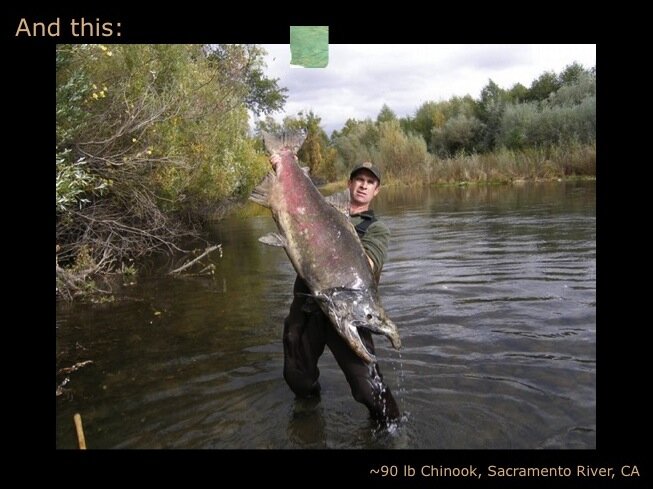 We really need to be careful when we start batting around terms like “restoration”…
We really need to be careful when we start batting around terms like “restoration”…
It’s important to ‘mean what we say and say what we mean’…
Hatchery interventions can be used to assist in rehabilitation of some areas… however, they can’t be a permanent solution.
Let’s for example look at some of the numbers quoted in the success of DFO’s enhancement efforts.
If they’re getting 0.1% return on investment… does that sound like a sound strategy? That’s worse returns then the common chequing account these days…
But then the initial goals of the Salmon Enhancement Program were:
The Salmonid Enhancement Program (SEP) was established in 1977 with objective of restoring stocks of salmon to their historic levels of abundance.
How’s that going?
_ _ _ _ _ _
Making comparisons to Alaskan returns, just isn’t going to cut it.
Different practices (e.g. ocean ranching); different migration patterns; different investments; different priorities.
Seems its convenient in situations like test-tube salmon babies to forget the issues in the ocean — e.g. lower productivity, etc. — but when it comes to judicial inquiries, fisheries ‘management’, etc. then all of a sudden the discussion of poor ocean conditions and the like become prevalent.
(is that because it makes easier… rather than looking in a mirror… and at history)
At some point we need to make a choice on what the issues are…
For example, what’s the point of spending millions of dollars to send test-tube babies out to the ocean if productivity remains low…?
what’s the point of sending test-tube babies out to the wild if the streams they have to return to are largely clearcut to the banks…?
Go down to the Lower 48 and see what sort of success they’ve had at spending upwards of a billion $$ on salmon habitat rehab and hatcheries… ask how many fish they’re catching?
_ _ _ _ _
We are far past the point of “restoring” salmon.
Are we all that far off from basically preserving zoo populations and setting up kids fishing ponds…?
Rather than fumbling around trying to do better what nature already does perfectly (for millions of years) why don’t we clean up the mess we made in the first place?
The problem with salmon isn’t that they need “help” reproducing… they been doing that well before we came along. It’s more that if we’re all to co-exist; then we need to look after the neighborhoods that we co-exist in… for example: watersheds, rivers, lakes, and so on.
With the rapid changes coming due to climate change (less cold water, ocean acidification, water shortages, etc.)… wild salmon are going to need a lot of help making sure their neighborhoods are fit for spawning, dieing, and reproducing in.
Just like your neighborhood… pretty hard to spawn in a mudslide isn’t it?
(fun to wrestle in maybe… not so much fun after that…)

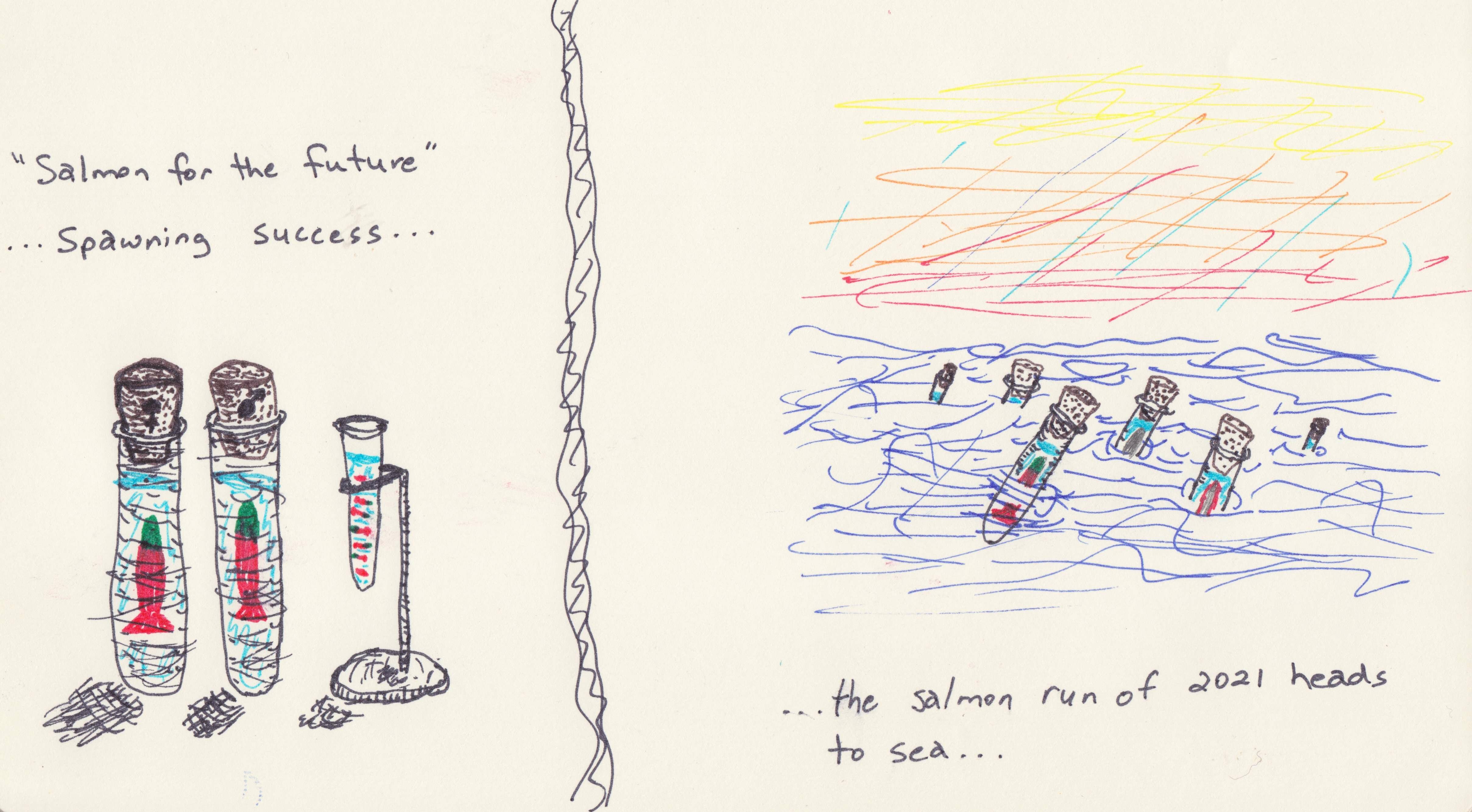


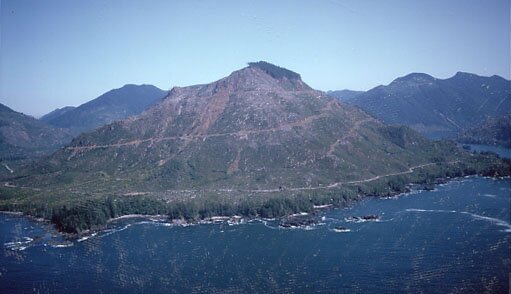
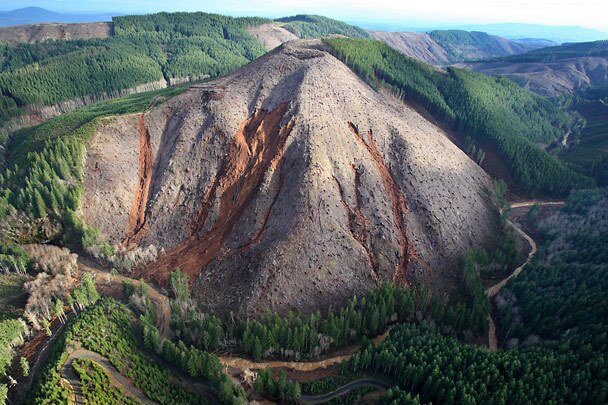


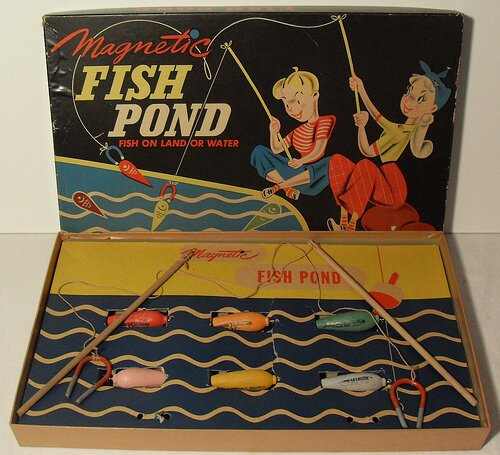
I think your interpretation of this project is a little off here…
Firstly the attempt to mimic nature was directed at the idea that chinook have several phenotypes (S0, S1, S2 and even S3 depending on temperature) which identify how long the fish stays in the river before it goes to sea.
These different types have evolved to capitalize on different areas of the river and will spawn at different times as well as having great differences in body size due to staying out at sea for years longer.
The current practice of releasing S0 fish means that only one type of chinook is represented in enhancement efforts.
They mostly all return at the same time (3 years at sea) and do not grow to the large size traditionally seen in some runs.
This tecnique allows for a percentage of the eggs taken for these projects to be raised beyond the usual DFO template ( they are also disease screened as per aquaculture practices ) in order to ensure that a number of phenotypes are represented in the population.
The fish that return from the S1 component will stay out a number of years longer, come back bigger and provide insurance against differing conditions between years.
Along with the 3 to 4 times greater rate of return it is an exciting project which may ensure that the runs which are enhanced can have a chance to become self sustaining.
It is hoped that with a coordinated effort to address some very low numbers of chinook we can help give these populations a boost using technology and practices honed in decades of producing healthy and strong fish for aquaculture.
thanks James,
fair enough… as the saying goes… things are open for interpretation.
i’ve been involved in projects in the past that utilize hatcheries in a limited fashion to try and assist runs and streams on the verge of extinction, or already there. From what i can see on escapement counts… the Sarita and Nahmint Rivers are not on the verge of ‘extinction’ when it comes to Chinook. It appears the 12 yr avg. in Nahmint is 470 Chinook and 2,000 for the Sarita. (and I sure hope the Phillips doesn’t refer to the Phillips east of Campbell River?)
This doesn’t appear to be just about giving the “populations a boost”…
What would the populations be in those rivers if several of the fisheries I refer to in today’s post were curtailed; e.g. West coast Van. Is. troll fishery or the commercial sport fishery that dominates the west coast of Haida Gwaii and Vancouver Island — including the gauntlet that the Nahmint and Sarita Chinook must run just to get upstream?
Unfortunately, my cynicism of these types of practices suggest — as i’ve mentioned before: ‘everything is marketing; marketing is everything.’ Not to suggest that there aren’t good intentions involved in this project — just doesn’t seem to fit with the precautionary principle, nor what has been learned from hatchery practices and wild salmon populations.
Appreciate the discussion though… thanks again.
The simple truth is that the vast majority of people who are intersted in saving, or increasing the number of wild salmon, want to do so in order to have a chance to kill them.
Commercial and sport fisherman, First Nations and general public diners are all interested in killing/eating salmon.
There are a small number out there who simply wish to have salmon for the sake of there being salmon and would not harm them for profit or food.
(There is also the element of having salmon as part of the natural food chain and nutrient system, but that is another argument, this is focused on chinook)
What I am getting at is that sooner or later all fisheries and enhancement efforts are going to be of the “terminal” nature.
Unless all pressure is removed for a considerable amount of time (and even then this may not accomplish what is hoped) there is very little chance that any runs will increase in number.
Environmental well-wishers and others who would walk down the path of removing impacts in order to protect salmon runs will soon find that they are in a place with no people.
The only problem is that the majority of these river systems are situated inside heavily or moderately populated areas due to the fact that the fish most likely brought the people there in the first place.
If we want to continue to remove fish from the wild we have to find ways to put them back through enhancement and provide alternative sources through aquaculture.
This method serves to create a more robust population of fish using proven methods and with the ability to ensure that no diseases are present when fish are released back into the rivers.
I think it is only natural that we move towards producing fish for our needs because the alternative is unacceptable.
James,
you had me for the first half of that comment, but the last half I found truly disappointing…especially the last sentence.
kd
Thanks James,
all fair points… one thing I would differ on is that there is far more then a “small number” of folks interested in protecting salmon for the sake of having salmon. Estimates suggest over 100,000 BC’ers engaged in streamkeeper groups, etc. Certainly some of these are folks interested in having hatcheries simply to support rec fisheries — however, i’ve always suggested never doubt the interest of folks around the Pacific Rim when it comes to salmon. They are deeply imprinted on people’s psyche…
I’m not so sure it’s a matter of removing ‘all pressures’… the one pressure that is the most obvious is catching a killing a member of any population… that has an impact. In situations of over-population (e.g. a plague of locusts…), then maybe the impact isn’t negative. However, in the case of severely depleted populations — like many salmon, including West coast Vancouver Is. — reducing fishing pressure would have positive impacts, and it has in the past. The problem, as you rightly point out, is that that reduction in fishing pressure is not maintained over a few life cycles.
I’m also not so sure that majority of rivers are in heavily or moderately populated areas. Maybe in the Lower 48 — but not in BC. The lower and mid Fraser are about the only heavy to moderately populated areas in BC. And maybe sections of the Skeena — the rest of BC — pretty gently populated. Last time I checked there is pretty much only a small village and fishing lodges in Rivers Inlet… yet the salmon populations are severely depleted.
And yes, fish brought people, most likely… however, the difference is that the Fraser River basin used to be one of the most densely populated areas in all of North America pre-contact. That population was heavily reliant on fish – especially salmon. Some archaeological evidence suggests almost 90% of people’s diets were composed of fish. Some estimates suggest the pre-contact fishing pressure was heavier than the average commercial catches over the last 100 years.
There wasn’t any enhancement or fish production happening then. And somehow the salmon populations still supported an incredible diversity of people. Certainly there may have been lean years… but oral history doesn’t suggest any long periods of dwindling runs.
I certainly beg to differ on this assumption of “proven methods” and the ability to ensure no diseases are released back into rivers. The jury is most certainly still out on hatcheries. Last year, I attended an international conference in Portland, OR on this very issue: the interaction between hatchery and wild populations. Many folks curse hatcheries for devastating wild runs and simply setting up a perpetual hamster wheel of enhancement efforts. Look at the hatchery efforts on the Sacramento River for example. Creating “robust” populations… I’m not so sure.
And I have to agree with kd’s comment on the last sentence… however, also recognize that raising fish as a practice is thousands of years old (e.g. China), but not in an industrial setting like the “salmon feedlots” (as some folks refer to them) of today.
There was a time when nature produced all that humans need — whether it was a hunter-gatherer society or an agrarian society. The same went for salmon; they supported thousands upon thousands of people for thousands upon thousands of years. Then “fishery management” and “fishery science” came along and the fish have never recovered… (granted populations boomed as well…)
thanks for the comments, it is an interesting conversation.